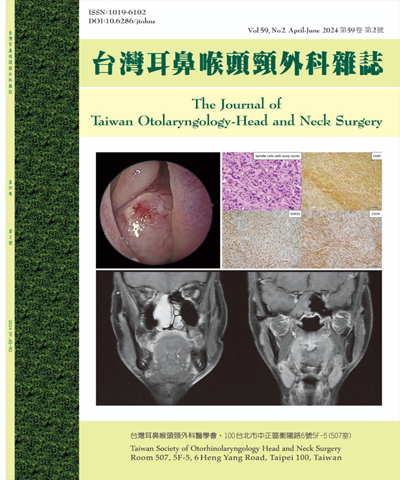
台灣耳鼻喉頭頸外科雜誌/The Journal of Taiwan Otolaryngology-Head and Neck Surgery
台灣耳鼻喉頭頸外科醫學會,正常發行
選擇卷期
- 期刊
自2019年底以來,2019新型冠狀病毒肺炎(COVID-19)大流行席捲全球。以往文獻曾報導中耳和乳突中存在有其他冠狀病毒,這表示在常使用霧化步驟的耳部手術中存在著醫護人員感染的風險。因此,在許多耳科手術中,由於中耳和上呼吸道相通,有很高風險COVID-19病原體會經由飛沫氣霧從上呼吸道傳播到中耳。本文的目的是為耳科檢查處置和手術提供適當的防護建議。常規耳科手術應延期,緊急/急迫性手術必須在加強型全套個人防護裝備(PPE)下進行。一般防護措施包括佩戴PPE套件(N95口罩,動力濾淨式呼吸防護具,雙層手套、護目鏡、面罩、長袍、鞋套)、使用負壓室並減少必要人員的出勤。本文回顧使用高速器械儀器的乳突手術和遠程聽力檢查評估聽力安全防護問題的相關文獻。希望全國能遵守安全建議,共同安然度過疫情。
- 期刊
2019新型冠狀病毒(COVID-19)的出現,造成世界各地疫情蔓延,世界衛生組織(WHO)也在2020年3月11日宣布COVID-19疫情為全球大流行(pandemic)。台灣在2020年時雖藉著優異的防疫措施,成功控制國內疫情,但在2021年也不得不開始面對國內疫情的擴散。部份COVID-19確診的病人,可能因為氧氣需求高但困難插管,或為避免因長期氣管內插管造成呼吸道、喉部、氣管的傷害,因而考慮氣管切開術。身為耳鼻喉頭頸外科的呼吸道專家,我們更需要了解何時、何地及如何在COVID-19疫情下安全地執行氣管切開術。本文旨在參考美國耳鼻喉科醫學會、英國耳鼻喉科醫學會、及各類國內外文獻指引,分析氣管切開術在疫情下的角色,以提供台灣耳鼻喉頭頸外科醫師在COVID-19疫情下施行氣管切開術的相關照護建議。
- 期刊
背景:本研究主要目的為探討腮腺切除手術,可能影響顏面神經探測器與顏面神經反應偵測的相關因素,並建立可靠的顏面神經反應預測值,提升手術中顏面神經探測器監測品質。方法:回溯性分析51名於2013年11月至2015年12月期間,接受腮腺腫瘤切除手術,且術中使用顏面神經探測器之病患,分析病患性別、年齡、體重、腮腺腫瘤部位與深度、腮腺切除體積、腮腺腫瘤大小、肌肉鬆弛劑給予的藥物劑量及定位顏面神經主幹之花費時間,與顏面神經偵測反應之相關性。結果:本研究共有51名病患參與,47名(92.2%)患者組織病理報告為良性腮腺腫瘤,4名(7.8%)則為惡性腮腺腫瘤,手術後發生暫時性顏面神經麻痺的機率為19.6%,而90%顏面神經受損之病患均於3個月內完全恢復正常功能,永久性顏面神經麻痺機率為1.9%。男性之初始顏面神經偵測反應平均值(739.6 μV)明顯高於女性之反應平均值(443.4 μV, p=0.025),而腮腺組織切除體積大小(Pearson correlation coefficient: r = 0.302, p=0.031)、肌肉鬆弛劑施打至分離顏面神經主幹之時間差(Pearson correlation coefficient: r=0.406, p=0.003)與顏面神經震幅比值具有明顯相關性,可以採用神經震幅比值用來預測手術後顏面神經功能。結論:合併顏面神經初始偵測之神經反應及腫瘤完整切除後之神經反應,所得之神經震幅比值,更適合用於預測術後顏面神經麻痺的受損和恢復程度。如果神經震幅比值大於一,則患者可能有較高機率出現術後顏面神經麻痺。
- 期刊
背景:能力導向醫學教育(competency-based medical education)是未來醫學教育的典範,而「學習里程碑」評量則是達成能力導向醫學教育的方法之一。台灣版「耳鼻喉頭頸外科學習里程碑」於2017年完成,並於2019年起試行多中心評量,評量過程需耗用大量人力、物力及時間,因此著手建構線上自動化的學習里程碑評量系統。方法:我們先運用Google表單將台灣繁體中文版「耳鼻喉頭頸外科學習里程碑」電子化,為各訓練醫院的客制化評量表單,並撰寫Google雲端運算服務應用程式,建立線上自動記分及表單分發流程,使系統成員能隨時隨地進行自評或複評,無需自行計算分數,再結合社群軟體功能進行聯繫工作,包括基本資料登入與里程碑表單的傳送等,評量完成後自動產生報表,提供訓練醫院計劃主持人參考,系統完成後共進行兩次多中心學習里程碑評量。結果:線上自動化里程碑評量系統與紙本作業流程相同,均可呈現住院醫師六大核心能力之進程,但線上自動化系統大幅減少紙資源的使用,計分錯誤比例由7.6%降為0%,學員及臨床教師的評量流程平均滿意度為4.7±0.5及4.8±0.4(李克特量表,1-5分,5分代表非常滿意),填寫紙本表單與電子表單所需時間無顯著差異。結論:本研究建構並導入線上自動化的多中心學習里程碑評量流程,實際執行結果已證實其可行性,能解決不同訓練醫院評量結果無法互通的現況,而且,本研究所使用的所有線上資源都是免費的。
- 期刊
Dentigerous cyst is the second most common type of odontogenic cyst after periapical cyst. The dental follicle of unerupted tooth is believed to be its origin, and the mandibular third molar is the most frequently involved tooth. Ectopic tooth is the erupted tooth outside the dental arch, which has reportedly been observed in the nasal septum, mandibular condyle, coronoid process, palate, and maxillary sinus. The etiology of ectopic tooth eruption is still unclear. Dentigerous cyst associated with an ectopic tooth in the maxillary sinus is somewhat rare. Symptoms related to rhinosinusitis usually appear late in the process. Surgical approaches include transoral Caldwell-Luc procedure or transnasal endoscopic surgery, and the standard treatment is the enucleation and extraction of the associated tooth. In case of large cysts, marsupialization decompression is advocated. A 41-year-old woman with the complaint of postnasal drip and hyposmia for the last 2 months presented to our ENT department. Noncontrast sinus computed tomography scan revealed an ectopic tooth located in the posterosuperior aspect of the left maxillary sinus and surrounded by an expansile cyst. This case report demonstrates a minimally invasive management by transnasal endoscopic decompression via maxillary antrostomy, followed by removal of most of the cyst lining epithelium while preserving the ectopic tooth, to prevent internal maxillary artery injury and oroantral fistula formation. The patient remained asymptomatic over a postoperative follow-up time of half-year, and no recurrence was observed on sinoscope examination.
- 期刊
耳內圓窗及卵圓窗可能因氣壓劇烈變化而破裂,產生外淋巴瘻管而引起外淋巴液滲出,導致聽力障礙與不平衡感。因自由潛水所造成的外淋巴瘻管,為臨床上少見之病例,由於症狀不具專一性,因此難以在治療前得到明確的診斷。往往需要相關潛水病史、病患出現波動型感音神經性聽力喪失,甚至經由鼓室探查手術才能診斷出來。本文報告1例31歲男性因深度自由潛水引發單側聽力障礙及不平衡感,疑似外淋巴瘻管,經鼓室探查手術並利用耳垂軟組織填塞圓窗及卵圓窗後,病患聽力恢復正常且頭暈改善。本文分享此案例並討論自由潛水造成的外淋巴瘻管。
- 期刊
呼吸道狹窄與阻塞,一直以來是呼吸道急症裡一個重要的議題。1名59歲女性,在4年前因為聲音沙啞到他院求診,診斷是左側的甲狀腺,疑似惡性腫瘤合併同側聲帶麻痺。由於氣切可能是治療選項之一,患者繼而拒絕治療及後續追蹤。然而最近半年因為呼吸困難加劇伴隨喘鳴至本院就診。理學檢查發現左側有一顆硬且不規則的甲狀腺腫瘤。在鼻咽喉內視鏡檢查發現左側聲帶麻痺。頸部的電腦斷層報告顯示有雙側不對稱的多發性甲狀腺結節,並且左側甲狀腺腫瘤由聲門下位置直接侵襲進入氣管壁,腫瘤的大小約29×35×33 mm。由於病人的呼吸道有嚴重的阻塞,透過氣管內管置入術或者是緊急氣管切開術去做呼吸道的支持是有困難的,經過與胸腔外科和心臟外科討論之後,並且與病人以「醫病共享決策」模式充分溝通,決定先使用體外膜氧合(ECMO)來支持病人的血氧濃度,接著用支氣管鏡清除氣管內的腫瘤後,全身麻醉下進行雙側全甲狀腺切除術併左側頸部淋巴廓清術。病人術後順利移除ECMO,並且在術後第3天順利移除氣管內管。此病例報告提供另一種呼吸道支持的選擇。
- 期刊
The incidence of post-traumatic cerebrospinal fluid (CSF) leakage after blunt head injury ranges from 2% to 4%. About 80% of leaks occur within 48 hours after the injury, and 95% manifest in 3 months. Conservative measures are effective in approximately 60%-70% patients with traumatic CSF leaks. However, if leaks persist, surgical intervention is needed. Here, we have presented our experience with a case of traumatic sphenoid sinus fracture complicated by CSF leakage and pneumocephalus. The patient was managed conservatively by a neurosurgeon, but CSF leakage persisted. Therefore, transnasal endoscopic repair was performed 8 days after the trauma. After enlarging the left sphenoid sinus natural ostium, a small defect was identified at the posterior wall of the left sphenoid sinus. Bone chips and the surrounding detached mucoperiosteum were removed, and the basilar artery was visible through the defect. The bath-plug technique using the fat tissue obtained from the abdomen was applied to repair the defect. Then, a free mucosal graft harvested from the left nasal septum was used to cover the fat plug and defect area. A TISSEEL fibrin sealant was used. The left sphenoid sinus cavity was packed with Gelfoam®. The patient recovered well after surgery. There was no recurrence of CSF leakage thereafter.
- 期刊
Transoral robotic surgery (TORS) is a minimally invasive surgical technique for patients with head and neck cancer, the oncologic outcome of TORS was comparable to traditional open surgery recently. Therefore, TORS was an option for selected patients with lower grade laryngeal cancer. For the consideration of rapid functional recovery and life quality preservation, one man with subglottic adenoid cystic carcinoma underwent TORS. Because there was difficulty to establish safety margin, the patient accepted local radiotherapy and no evidence of recurrent cancer after 30 months follow up; however, bilateral vocal palsy was noted 3 months after radiotherapy.
- 期刊
Unilateral abducens nerve palsy (UANP) is a very rare condition in adults, especially as a postoperative complication in otorhinolaryngology surgeries. The most recognized etiologies of UANP include cerebrovascular disease, undetermined factors, and trauma, whereas other causes such as spontaneous intracranial hypotension, local anesthetic effects, intracranial neoplasm, multiple sclerosis, inflammatory disease, and viral infection are occasionally encountered. We present a 51-year-old woman who suffered from sudden onset of isolated left lateral rectus muscle palsy following functional endoscopic sinonasal surgery. The patient denied any underlying systemic disease, previous surgical history, neurological signs, or trauma history. Preoperative physical and fiberscopic examinations revealed hypertrophic turbinates, deviated nasal septum, and mucopus postnasal dripping. Sinonasal computed tomography without contrast reported chronic rhinosinusitis. The procedure was uneventful, and a blood loss of 300 mL was recorded. The postoperative neurological examination was normal except the occurrence of isolated left lateral rectus palsy. Her muscle power was intact in both upper and lower limbs as well. The left lateral rectus muscle paralysis recovered nearly an hour after the operation. However, only a few cases of postoperative UANP have been reported by the earlier scientists in the literature, wherein most etiologies include spontaneous intracranial hypotension, local anesthetic effect, and idiopathic origin. Finally, we propose that clinicians shall rule out the local anesthetic effect initially after functional endoscopic sinus surgery and undergo detailed surveys of spontaneous intracranial hypotension in healthy adults and cerebrovascular diseases in patients with systemic diseases.

